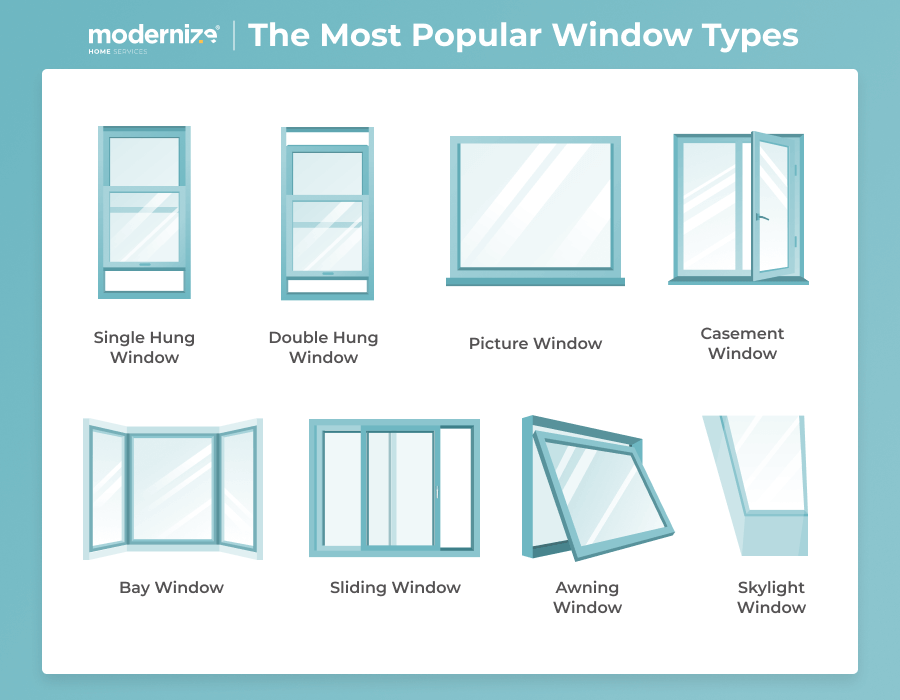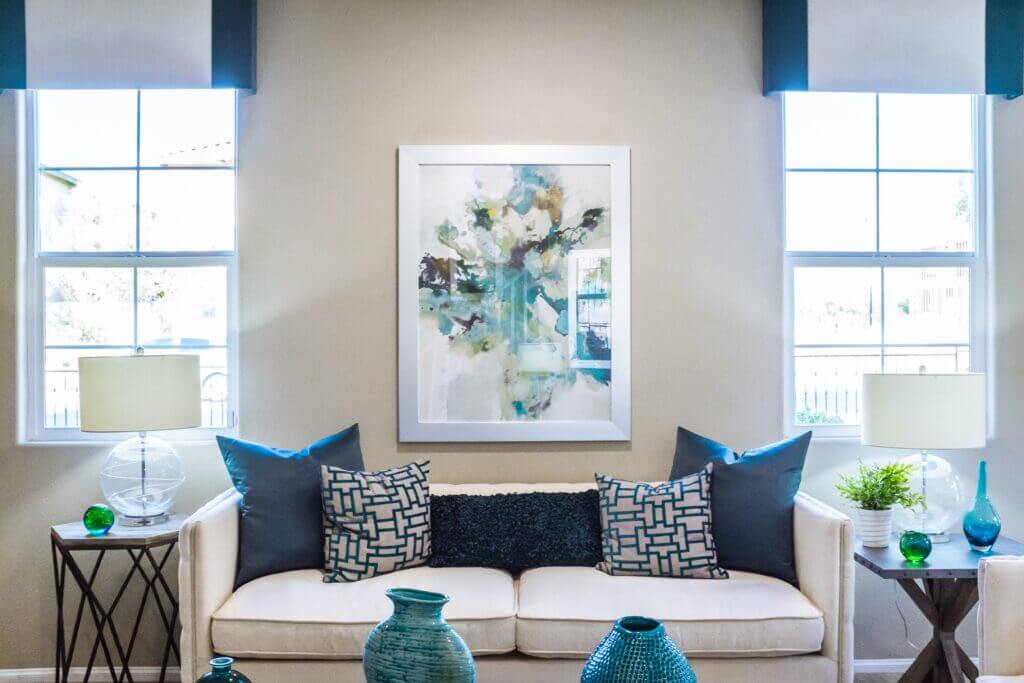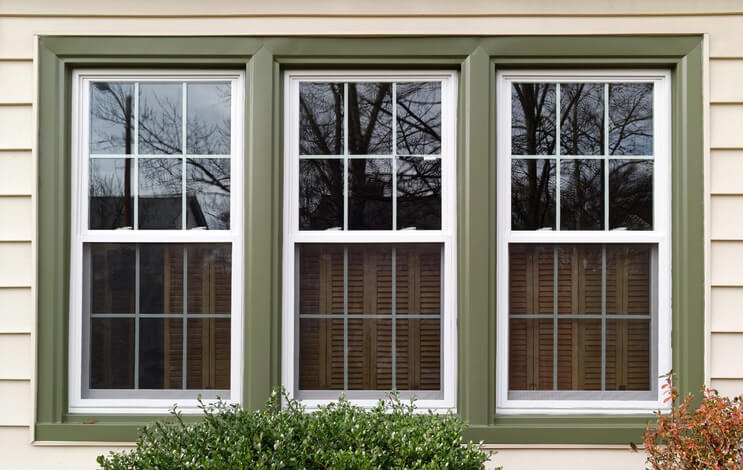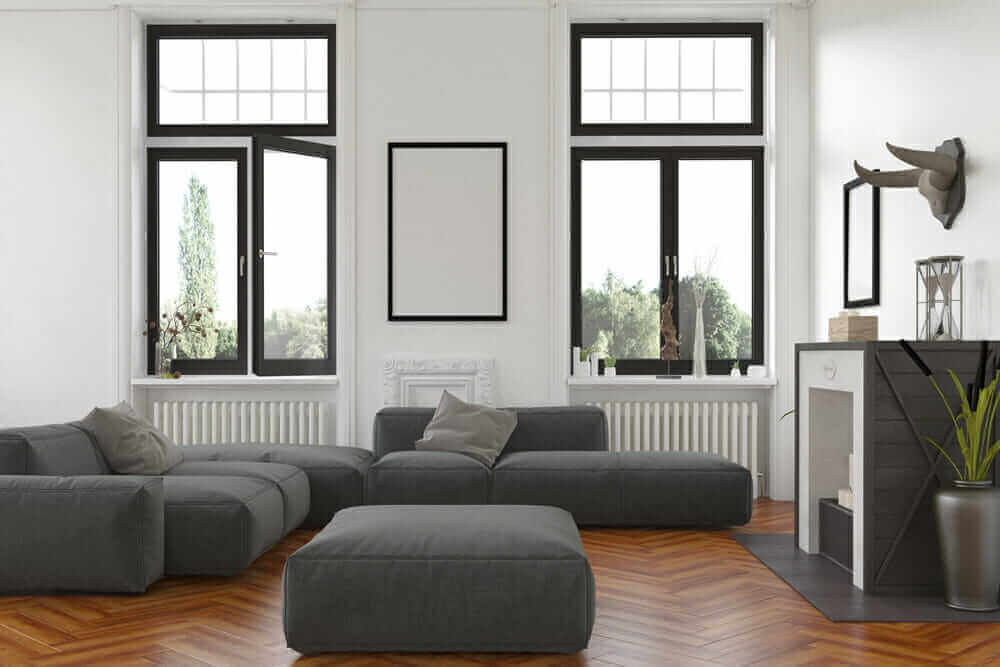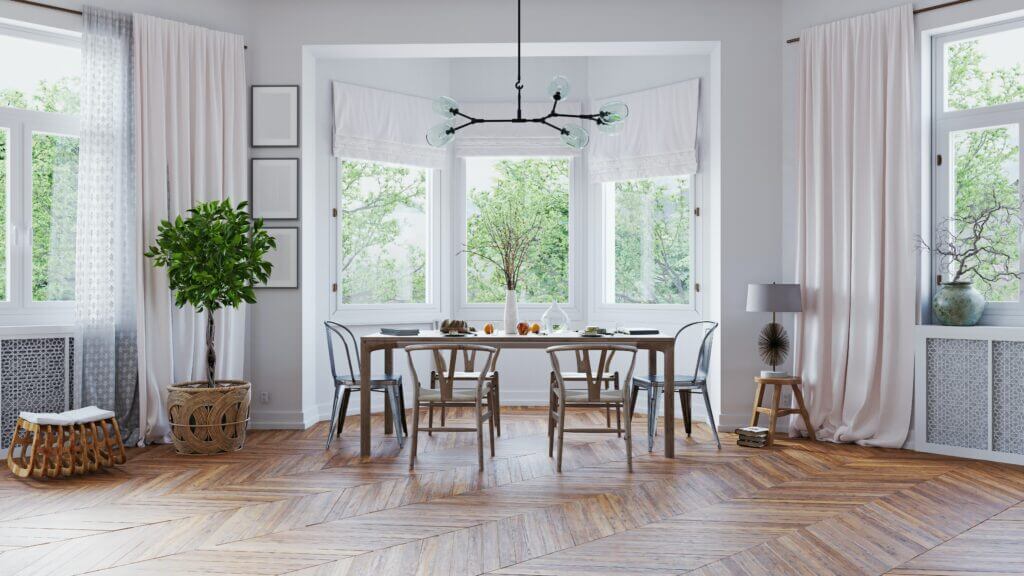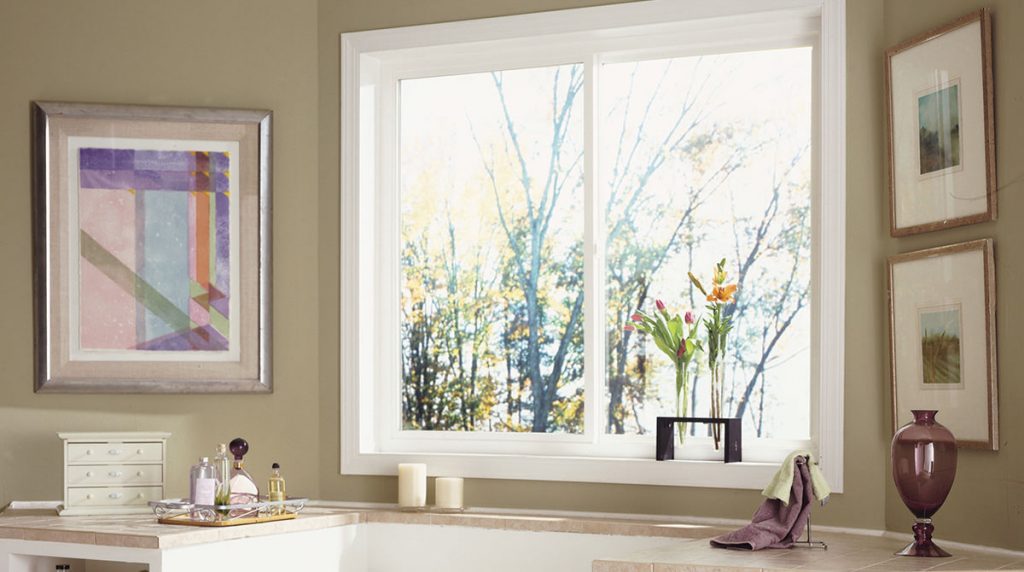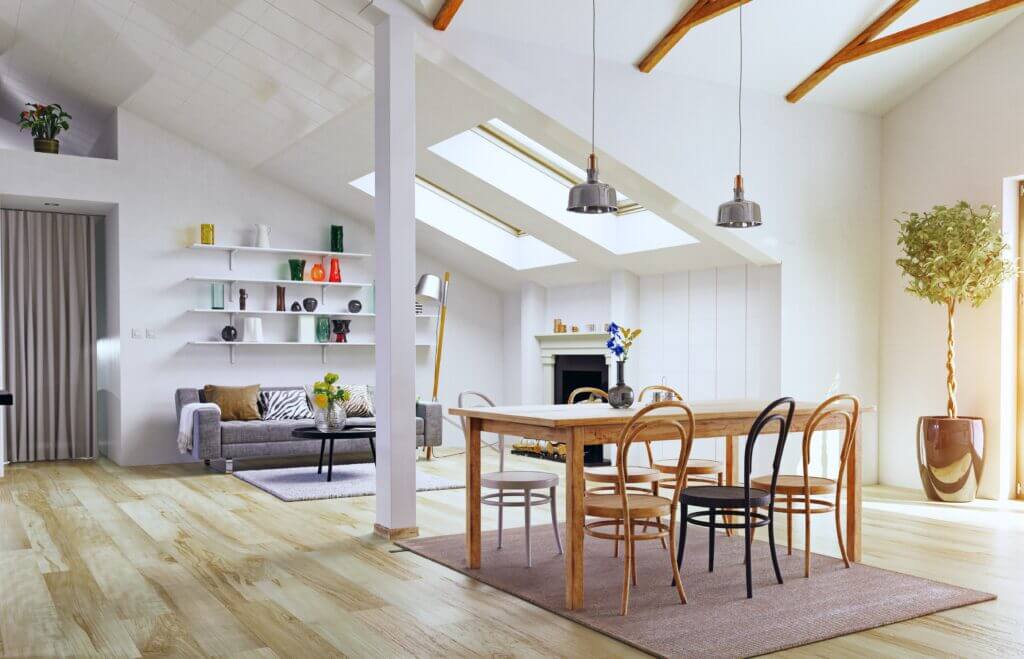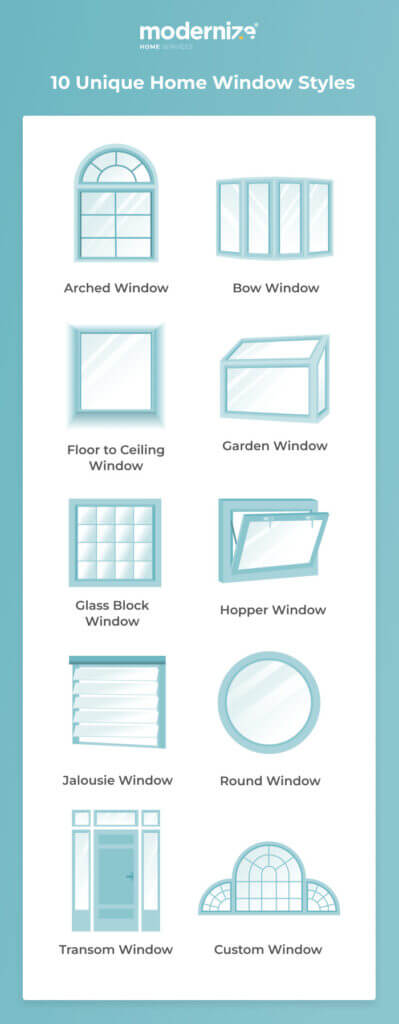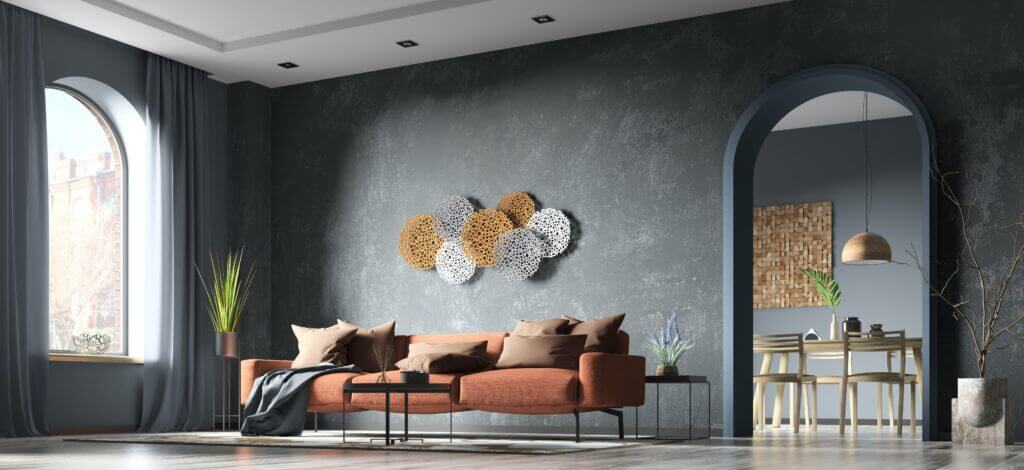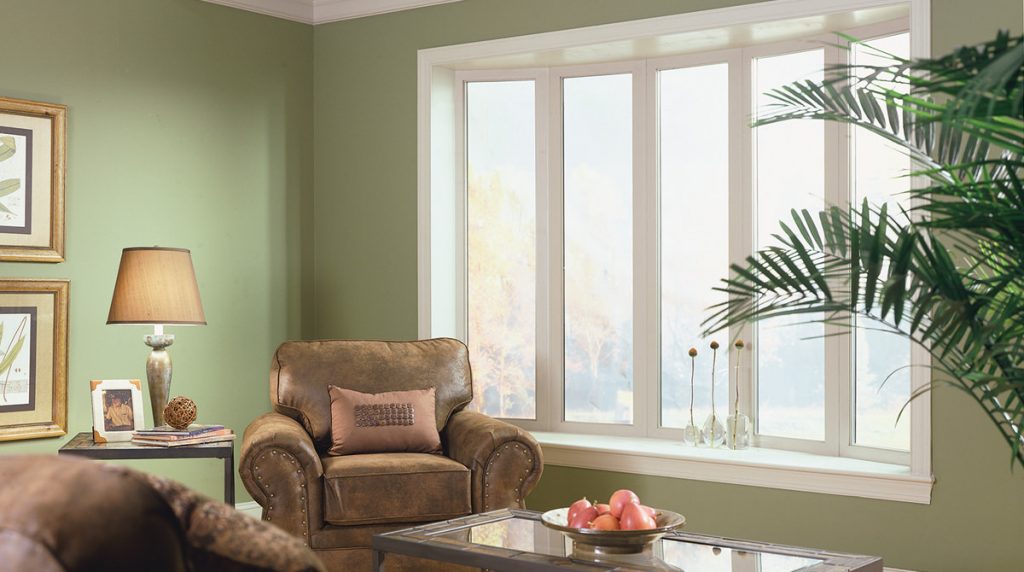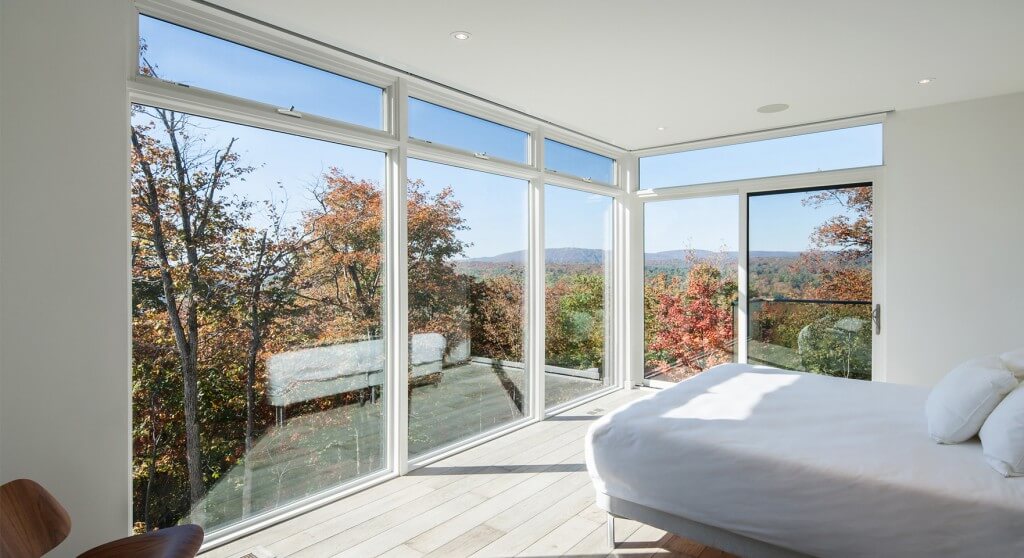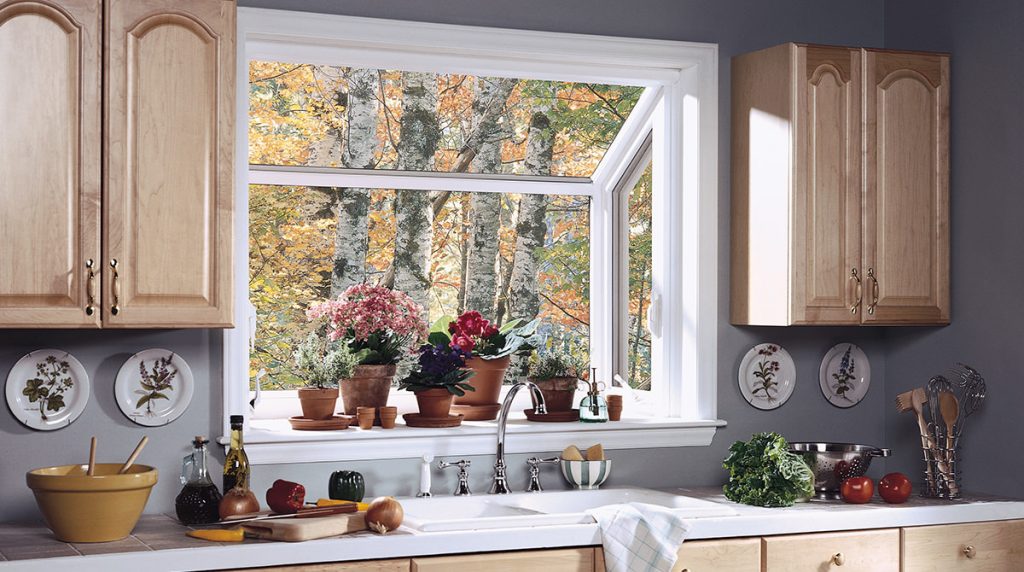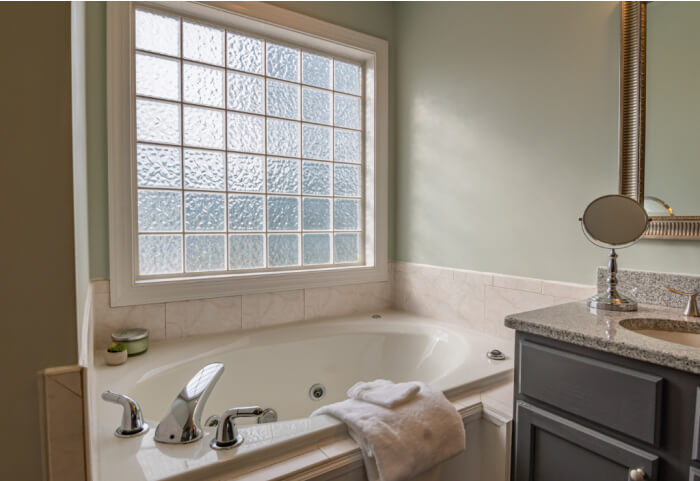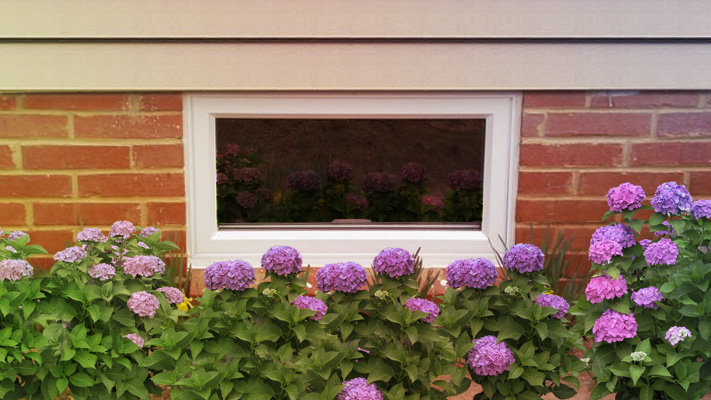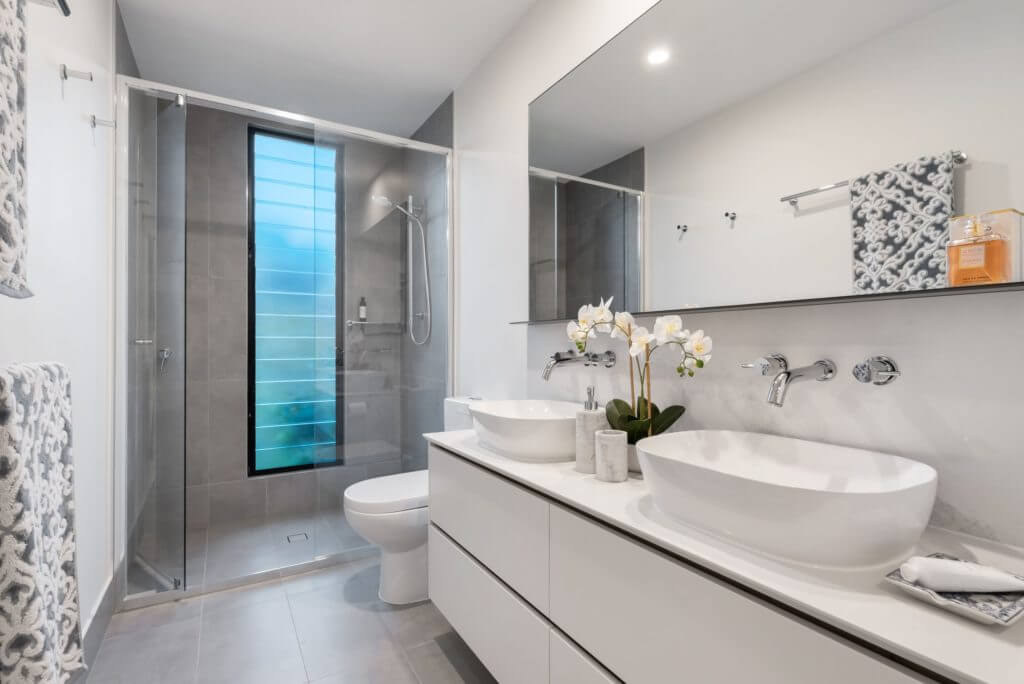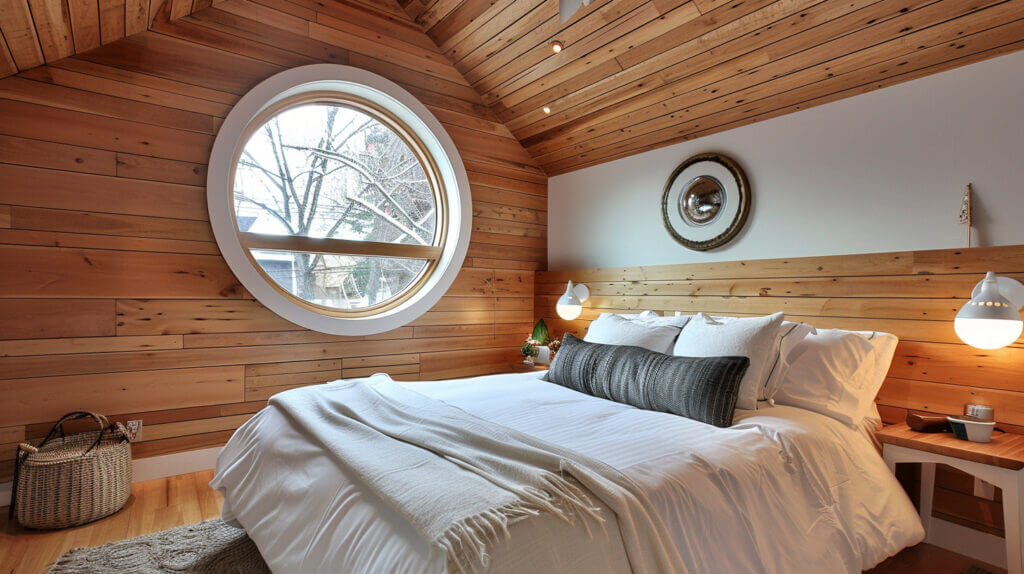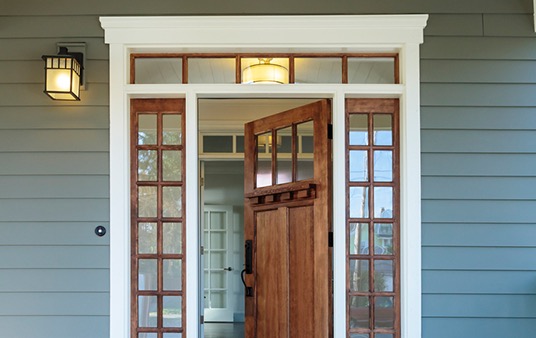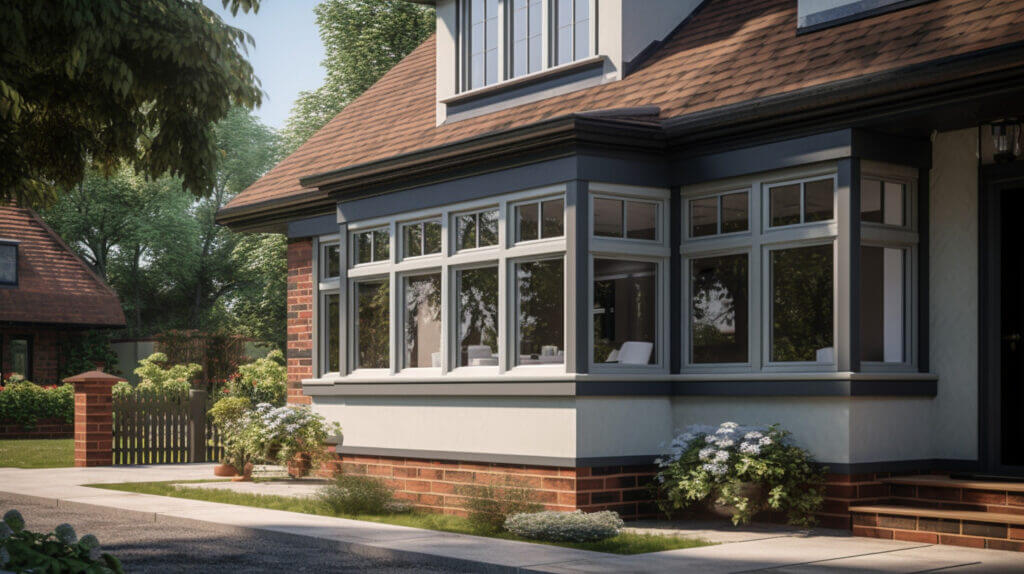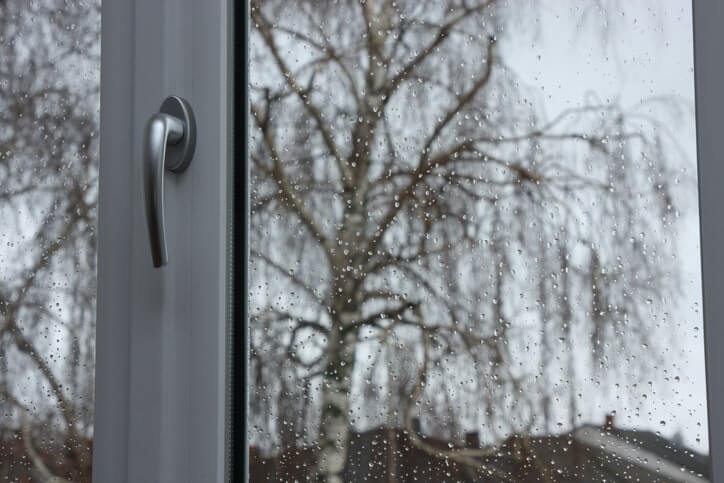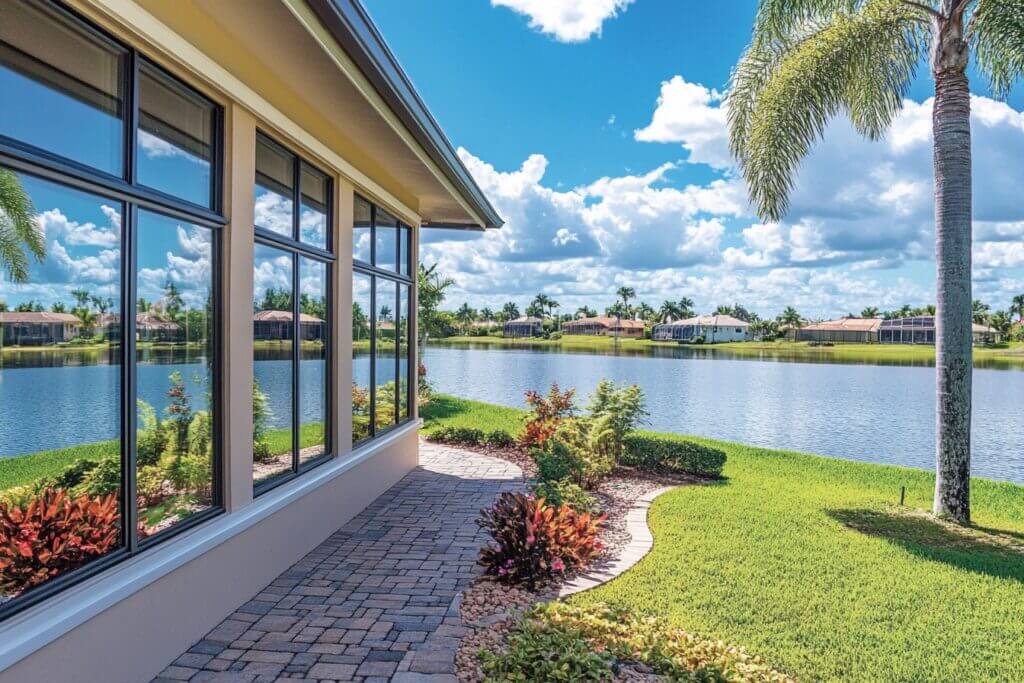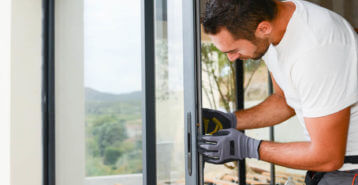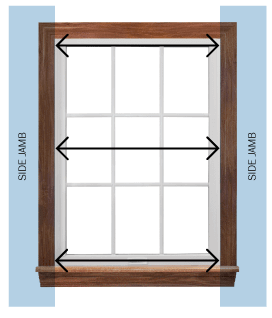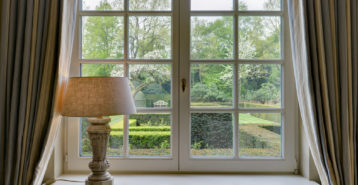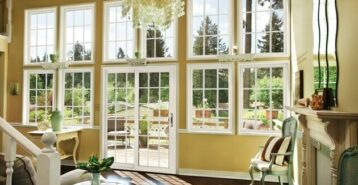Window Types: How Many Are There?
There are more than 20 window types available. Out of those, eight rank as the most popular:
- Double-hung
- Single-hung
- Picture
- Casement
- Bay
- Awning
- Sliding
- Skylight
We break each of these down below, along with their pros, cons, and average cost. But before we dive in, here’s what to know about window types.
Best Types of Windows by Room
When considering window types for different rooms in a home, the choice often depends on factors like light, ventilation, privacy, and the aesthetic appeal of the room. Below, as you browse through window types, you’ll see we’ve noted which rooms homeowners install them in most often. Here’s a quick table showing our picks.
| Room | Window Type | Why We Recommend It |
|---|---|---|
| Living Room | Bay, Picture, and Casement | Expansive views and lots of light. |
| Kitchen | Sliding, Garden, and Casement | Easy to open, provide light for herbs and plants, and offer great ventilation. |
| Bedroom | Double-hung, Casement, and Awning | Versatile ventilation to encourage air flow and allow for lots of light. |
| Bathroom | Awning, Glass Block, and Hopper | Great for privacy and small spaces while still providing good light. |
| Dining Room | Picture, Casement, and Bay | Maximize light and views to the outdoors while promoting air flow. |
| Home Office | Double-hung, Bay, and Picture | Great views and lots of light to enjoy. |
Some of these rooms include options that aren’t among the eight most popular window types. We will look at all the window types outside of the most common options further down on this page.
What About Vinyl Windows?
Many homeowners look up window types to learn more about vinyl windows. But this actually falls outside the scope of types of windows. Window type focuses on how the window functions (does it slide sideways? Open outwards?) whereas frame type focuses on look, material, and energy efficiency. You can visit our guide to window frames for more information as well as our guide to vinyl windows if that is the frame material you are most interested in.
8 Most Popular Window Types
Here is what window type most homeowners choose for their window replacement project, pros and cons of each, and average cost.
1. Single-Hung Windows
- Best for: Hallways and stairwells, or any room where a double-hung window is recommended.
- Cost: $397 to $847
-
Pros
- Very affordable
- Simple to use
- Classic style that looks great on most homes
-
Cons
- More limited ventilation than other window types
- Can be difficult to clean
Single-hung windows open vertically with their bottom window panel (or lower sash, if you want to use the technical term) moving up and down, and the upper sash remaining stationary. This means that when you open the window, the upper sash is covered on the inside. These windows work well in most rooms, but may be best suited for areas that need less ventilation, like hallways or stairwells. However, they are an excellent alternative to double-hung windows for any homeowner on a budget, and work in all the rooms recommended for double-hung, like bedrooms, basements, and living areas.
You can visit our page on single-hung window costs to get more information on pricing, or visit our guide to single-hung windows to learn more about the window type itself.
2. Double-Hung Windows
- Best for: Bedrooms, living areas, upper floor rooms, kitchens, and bathrooms.
- Cost: $429 to $915
-
Pros
- Versatile ventilation
- Easy to clean since they can tilt out
- Safe choice for families with young kids
-
Cons
- More opportunities for air leaks
- More expensive than single-hung
Double-hung are the most common type of window found across homes in the U.S. On a double-hung window, both the lower sash as well as the upper sash can move up and down. They also usually tilt out for easy cleaning and maintenance. They are available in a great range of sizes and materials from all the top brands along with custom options for your homes. Since they can open from the top only, they are both excellent at venting heat from upper floors as well as safe for homes with young kids who will not be able to reach the open portion of the window. Double-hung are also a good option for any room that needs lots of ventilation, like a kitchen or bathroom.
We have a page devoted to double-hung window costs if you want a more detailed look at pricing. You can also visit our guide to double-hung windows if you want to learn more about what they look like, how they work, and if you should consider them for your own home.
3. Picture Windows
- Best for: Living rooms, dining rooms, or anywhere you want to maximize scenic views.
- Cost: $609 to $1,298
-
Pros
- Let in lots of light and showcase views
- Very energy efficient
- Low maintenance
-
Cons
- Cannot be opened, so less versatile than other window types
- Potential for solar heat gain or loss
Whether the view outside your home is a lush green backyard or a mountain range, the best way to fully enjoy it is with large picture windows. Picture windows cannot be opened, so they do not have any breaks or visible frames, resulting in an unobstructed view. They can make a room look larger, and typically are lower in price than many other windows since there are no moving parts to account for during manufacturing. They also are a very energy efficient choice since there are no spots for air to leak in or out like there are in windows that open. However, their fixed design also means they don’t offer any ventilation and can’t be used as the only window in a bedroom (there needs to be a window you can escape through in your bedroom, per building codes). All that glass also means the potential for solar heat gain in the summer or loss in the winter.
You can visit our guide to picture windows to learn more about this window type and if it’s the right one for you. We also have a page on picture window cost if you’d like a more detailed look at pricing.
4. Casement Windows
- Best for: Kitchens, bedrooms, bathrooms, and living rooms.
- Cost: $597 to $1,273
-
Pros
- Excellent ventilation abilities
- Great energy efficiency
- Offer clean, unobstructed views
-
Cons
- Safety and security concerns
- Size limitations
Casement windows have a crank handle, and when you turn it, the window opens out instead of sliding up or down. This allows the window to be constructed of solid glass and offers a less obstructed view overall, similar to a picture window. It’s an excellent option if you essentially want a picture window that opens. They are also very energy efficient – when closed, casement windows seal tightly against their frames, reducing air leakage. However, you may not want to use these windows on the second floor if you have young kids since they open so fully. Ask your contractor about any enhanced safety features if that’s the case. Additionally, if you have a large opening for a window, then the weight and stress on the hinges from a casement window may not make it the right choice. Again, ask your contractor for an opinion.
We have a page where we break down all the facets of the cost of a casement window. You can also check out our casement window guide for more information.
5. Bay Windows
- Best for: Kitchens, bedrooms, dining rooms, and living rooms.
- Cost: $1,732 to $3,690
-
Pros
- Versatile design and aesthetic appeal
- Enhanced views to the outside
- Increased space inside
-
Cons
- One of the most expensive window types
- Could require additional structural support
Bay windows are particularly well-suited for rooms where the goal is to maximize views and natural light while adding usable space and aesthetic value to the home. A bay window is actually made from three separate windows, and you can choose exactly which window type you want. The most common option is to have a picture window in the center flanked by operable windows, like double-hung or casement. However, depending on the size you choose and where you place it, you may find you need additional structural support to bear the window’s weight, which can make an already costly window even more expensive.
You can learn more about bay window costs or explore our guide to bay windows to get a better sense of if this is the best window choice for you.
6. Awning Windows
- Best for: Bathrooms, kitchens, and basements.
- Cost: $477 to $1,107
-
Pros
- Good ventilation, even during rainy weather
- Great energy efficiency
- More secure than some other window types
-
Cons
- Tend to be smaller than other window types
- Need enough unobstructed outdoor space to fully open them
Awning windows are hinged at the top and open outward from the bottom, creating an awning effect. This makes them especially ideal for rainy climates. They also tend to be one of the more affordable window options, though this is in part due to awning windows generally being smaller. Since they can be placed higher up on a wall than other window types, they are great choices for bathrooms since they provide privacy while still opening to vent humidity. They are also good choices for kitchens since they allow a lot of airflow. However, they are most popular in basements since they meet egress requirements, provide light and airflow, and are one of the most secure window types since they are very difficult to open from the outside.
Our page on awning window costs can help you get a better understanding of pricing, and our guide to awning windows can help you decide if this is the best window type for you.
7. Sliding Windows
- Best for: Bathrooms, kitchens, living rooms, and bedrooms.
- Cost: $775 to $1,652
-
Pros
- Design is good for unusual wall shapes
- Provide adjustable ventilation
- Can be made larger than some other window types, offering lots of light
-
Cons
- Sliding tracks collect debris and need to be cleaned regularly
- Not as energy efficient as some other window types
Sliding windows open horizontally along a track. This makes them simple and easy to use for people of many ages and abilities. However, the track the window slides in needs to be cleaned and maintained to ensure it functions as intended. With the many shapes and sizes this window comes in, it’s a great choice for an unusually sized wall space. It offers tons of light and ventilation, making it a wonderful choice for bedrooms and living areas, while also having an overall space-saving design that makes them especially conducive to areas like bathrooms and kitchens. Keep in mind that the larger the sliding window size you choose, the more difficult it can become to open over time due to overall window weight.
You can learn more about sliding window costs or explore our guide to sliding windows to get more information.
8. Skylight Windows
- Best for: Bathrooms, kitchens, living areas, dark hallways, and small spaces.
- Cost: $800 to $3,000
-
Pros
- Provide tons of light while ensuring privacy
- Add architectural interest
- Can increase home value
-
Cons
- At risk of leaking if not installed properly
- Can lead to increased heat gain as well as loss
Skylight windows are installed in the ceiling and can be fixed or operable. In addition to the beauty and architectural interest they provide, they also do it all in terms of window functionality: they can be fixed or operable, they let in lots of light, and they ensure privacy. However, they can also let in lots of heat in the summer and experience a lot of heat loss in the winter. To mitigate that, ask a contractor for recommendations on types of glass. Still, you may want to think twice before adding this window to a bedroom due to heat gain/loss concerns as well as the expense of adding an automated blind or covering to your skylight so your room stays dark. They work wonderfully in bathrooms, kitchens, and living areas to bring in light while venting out humidity and odors. They are also perfect for any dark areas of your home, like hallways, that may not have the wall space for a traditional window.
You can learn more about skylight window costs or simply read our guide to skylight windows if you want to get a better sense of whether this is the right choice for you.
How to Use Our Window Type Tool
We heard from our homeowners that trying to choose the right window type was a stressful experience, so we created a quiz you can take at the top of this page. To get our professional recommendation about what window types would work best for you, select what room you need a window in, if you want the window to be able to open, what you most want your window to do, and what your climate is like.
Then, we’ll show you your three best window type matches. We never require an email address to see your results.
You can also read on to browse a comprehensive list of all replacement window types outside of the eight most popular ones. Or, if you already know which options you’re most interested in, you can explore our main window home improvement page to instead browse our picks for best window brands, read our buying guide, and more.
10 Other House Window Options to Consider
If the most popular styles aren’t quite right for you, or if you have more specific windows needs — like a window for an especially narrow wall space or small entryway — then you may want to consider these additional options.
Since these windows tend to have more specialized usages, they don’t always have a best room we can recommend them for (though some certainly do). Instead, some are more suited to certain home styles or to specific homeowner needs.
If the most popular styles aren’t quite right for you, or if you have more specific windows needs — like a window for an especially narrow wall space or small entryway — then you may want to consider these additional options.
1. Arched Windows
- Best for: Architectural appeal.
- Cost: $345 to $950
Arched windows have rounded tops that add an appealing design element to any home. They can be manufactured with an arch or you can add a half-moon window above a standard rectangular window for the same look at a cheaper price. They can also be installed in a multi-arch structure with square or rectangle window panes on side, such as in the Palladian window style.
You can learn more about arched window prices or read our guide to arched windows to explore this window type further.
2. Bow Windows
- Best for: Victorian homes.
- Cost: $1,810 to $3,859
Bow windows create a circular area along the outside of the home, offering you extended views of your front or backyard area. Bow windows are also known as compass windows that utilize between four to six windows giving a Victorian look to your home. These windows can be a combination of fixed windows in the middle and ventilation windows at the ends.
You can read up on bow window costs to see if this window type fits in your budget, or you can read our guide to bow windows to learn more about them.
3. Floor-to-Ceiling Windows
- Best for: Adding light.
- Cost: $700 to $1,600
Floor-to-ceiling windows maximize light and views. In addition to making rooms feel bigger and brighter, floor-to-ceiling windows add architectural interest to your home. However, all that beauty comes with a high price tag. This custom project can involve anything from replacing a couple windows to adding an entire window wall.
Our guide to floor-to-ceiling windows cost can tell you all you need to know.
4. Garden Windows
- Best for: Over the kitchen sink.
- Cost: $1,000 to $4,000
Garden windows are essentially mini bay windows that are meant for plants. They have earned their name because they act like tiny little greenhouses that protrude from the inside of your home. You can keep plants and herbs on the mini shelves so that they can get the sunlight they need while still being protected from the weather and easily within reach.
Learn more about garden windows cost as well as explore our guide to garden windows to see more of these unique windows’ pros and cons.
5. Glass Block Windows
- Best for: Privacy.
- Cost: $400 to $1,100
Glass block windows are most often added to a section of the home to increase light flow but maintain privacy. They’re usually frosted or have a patterned design. They are ideal for use in bathrooms, basements, and other private spaces, but you should also consider them for areas where you need additional security since they are very difficult to break.
Check out our guide to glass block window costs to learn more about which homes and rooms can most benefit from this window type.
6. Hopper Windows
- Best for: Small spaces.
- Cost: $170 to $645
Hopper windows are great for any room with limited wall space for a new window. They open from the top and tip down. This window style makes efficient use of compact spaces, which is why hopper windows are commonly found in basements or bathrooms. They are also known for providing excellent insulation, because they seal up against the frame when closed all the way. You can read our guide to hopper window costs to learn more.
7. Jalousie Windows
- Best for: Bringing the outdoors in.
- Cost: $175 to $375
Jalousie windows are a unique window style that splits into many different slats of metal or glass. The windows open like a set of blinds. Simply crank the lever and the slats tilt to the side, which creates a series of gaps for air to flow through. They are often popular in coastal areas and are great for allowing in a nice breeze on a cool day with their enhanced airflow. But beware: they have very poor energy efficiency.
Our guide to jalousie windows cost can tell you more about this unique window type.
8. Round Circle Windows
- Best for: Gothic-era homes.
- Cost: $240 to $840
Round, half-round, elliptical, or oval—the round circle windows category encompasses many different shapes that add architectural interest to your home. In particular, round windows give your space a nod to historical décor, such as Victorian- or Gothic-era structures. Half-round windows can be combined with other window types, like picture and transom.
You can read more about round window costs, which are less than many other window types, as well as why they fit well with 2024 home design trends.
9. Transom Windows
- Best for: Near the front door.
- Cost: $334 to $711
Transom windows are used as decorative accents. They help break up space, add a unique design focal point, and let in extra light. They are typically installed near doors or on top of other windows.
You can read more about transom window costs in our guide.
10. Custom Windows
- Best for: The homeowner with a vision.
- Cost: 25% to 75% more than an off-the-shelf window.
When you have a space that you want to fill and standard types of windows are not meeting your needs, you can go with a custom window instead. Custom windows are crafted from dimensions that you or a professional measures in your home.
Read our guide to custom windows to learn more about what they might cost and why you might want to consider them.
Windows for Special Situations
There are a few windows that are only required in special circumstances. Here’s what to know.
1. Egress Windows
- Best for: Basements and bedrooms.
- Cost: $1,000 to $5,000
Egress windows are windows that open and that you can fit through in case of an emergency. They are required in bedrooms as well as in basements that have been converted into livable space. That means a sliding window, double-hung window, an awning window, or many other types can be considered an egress window. We have a blog post on egress window size to help you determine what type of window may fit in your space, as well as a post on the most popular types of egress windows.
You can learn more about egress window costs as well as explore our guide to egress windows.
2. Storm Windows
- Best for: Areas with extreme weather.
- Cost: $172 to $320
Storm windows are installed right in the same frame as your current windows on either the exterior or interior side of the windowpane. They are popular in areas with heavy storms and regions prone to hurricanes. Storm windows add another layer for blocking out drafts and making sure conditioned air stays in the home.
Learn more about what storm windows cost and whether they are right for you by exploring our guide.
3. Impact Windows
- Best for: Hurricane-prone regions.
- Cost: $300 to $1,500
Impact windows, also called hurricane windows, are far more durable and much safer than typical windows are. Some areas that see hurricanes or other extreme weather events may actually require them as part of their local building code. Though these windows cost more due to their materials and complex manufacturing process, their superior strength, energy efficiency, and ability to reduce noise pollution make them worth it.
You can learn more about hurricane windows cost ranges by visiting our guide. You can also explore all there is to know about impact windows and what makes them special.
A Note About Cost
We included the national average cost range for each window but be aware that some of the choices you make during your project can impact where in that range you land. Your cost will be impacted by:
- The window frame material you choose.
- The window glass type you need.
- How complex or easy your window installation is.
- Any water damage around your window that needs to be repaired.
- Local labor rates.
How to Choose Between Window Types
Looking through all those options above can feel overwhelming. How do you start narrowing in on the right window for your home? Here’s what to consider.
What You Need Your Window to Do
When deciding which type is best, start with your budget for the project. Then choose from the window types that fall into that budget by asking these questions:
- What window size do I need? Check out our guide on how to measure a window if you’re not sure.
- How do I need the window to function? For example, should it open outwards or inwards? Slide sideways? Are you okay with having a fixed window instead?
- Which room is the window being installed in? Some rooms, like basements, may require an egress window. Other rooms, like bathrooms, may be smaller and may need a window type or glass type that provides more privacy.
- How will the new windows look in the room? In addition to the window itself, consider how the look might change if you picked a vinyl frame versus, say, an aluminum one.
- How much light will the window let in? The other side of that coin is “how much heat will this window let in or let out?”
Picking a Good Window for Resale Value
You may also want to consider how the window you pick will impact your home’s value or your ROI. If you plan to sell your home in the next couple years, you may want to pick a window growing in popularity.
According to Rob Gruber, Vice President of Manufacturing at Champion Windows, casement windows are an emerging trend in modern home windows because they can open up a room while also adding home value:
“Casement windows are popular additions to modern homes because they offer large, unobstructed views of the outdoors. They also provide excellent ventilation and fresh air as they can be opened outward, rather than upward, to let a refreshing side breeze into your home. Add a casement window above a kitchen sink or in your living room or home office to frame the perfect view.”
— Rob Gruber, VP of Manufacturing at Champion Windows
Does It Matter Which Room the Windows Are Going In?
Yes, it does. As we’ve already laid out in this article, each room has special requirements. For example, you may want a living room window to help with airflow through your home, while a hallway or stairwell may simply need any window that lets in extra light. Here are a few final reasons why room type impacts window type:
- Building codes. Some rooms in your home are required to have multiple exit routes in case of emergency, including bedrooms and basements. If a window doesn’t open, you can’t use it as an emergency exit. That means you can’t pick something like a picture window (or at least not only picture windows throughout the whole room) since a picture window does not open and close.
- Room usage. If you’re putting a window in a shower, you probably want it to open to vent out humidity and steam. If you’re putting a window in a kitchen, you will want a lot of extra air flow to account for any smoke or smells. In a living room, you might not care as much if the window opens as long as it lets in lots of light. All of which is to say: the room itself and how it gets used will dictate which types of windows you want to consider.
- Ground floor vs higher floor windows. Another thing you may want to consider is which floor your new window is being installed on. If it’s on the top/only floor of your home, you can consider a skylight. You may also want to consider double-hung windows or other window types with lots of air flow for the top floor of your home since you will get better air flow higher up.
Final Thoughts on Your Window Replacement Project
Some window replacement costs can be negotiated with bigger projects or discounted with specials being run in your area by window installers.
Use our local window cost calculator to get average installation costs for new windows and break down your exact project estimate by window type.
You can also research best window brands to choose from and have a guide to make sure you are getting the best price in your area. If you are unsure about the specific window types you want to install, it may be more beneficial to speak directly to local contractors.
When you’re ready for quotes, browse our window contractor directory to compare pros in your area, or have Modernize do the research for you and match you with up to four pros who would be great for your project.
Ready to get your window replacement project started?
Compare top-rated windows pros in your area.
Read real homeowner reviews, explore qualifications, and view promotions. Modernize makes it easy to browse professionals and find one that will be perfect for your project.


